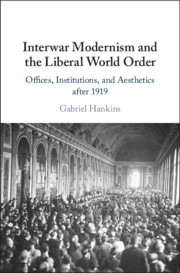Book contents
- Interwar Modernism and the Liberal World Order
- Interwar Modernism and the Liberal World Order
- Copyright page
- Contents
- Acknowledgements
- Introduction
- Chapter 1 The Queer Modernist Origins of Interwar Liberal Order
- Chapter 2 Friends and Enemies
- Chapter 3 The Artist as Clerk
- Chapter 4 Typewriter Fiction at the Secretariat
- Chapter 5 Black Modernist Internationalisms between the Wars
- Coda
- Notes
- Bibliography
- Index
Chapter 5 - Black Modernist Internationalisms between the Wars
Published online by Cambridge University Press: 15 August 2019
- Interwar Modernism and the Liberal World Order
- Interwar Modernism and the Liberal World Order
- Copyright page
- Contents
- Acknowledgements
- Introduction
- Chapter 1 The Queer Modernist Origins of Interwar Liberal Order
- Chapter 2 Friends and Enemies
- Chapter 3 The Artist as Clerk
- Chapter 4 Typewriter Fiction at the Secretariat
- Chapter 5 Black Modernist Internationalisms between the Wars
- Coda
- Notes
- Bibliography
- Index
Summary
Modernists of the African diaspora rethink liberal governance after 1919 through subtle critique (as in René Maran’s Batouala), through direct engagement (as in the Pan-African Congresses organized by W. E. B. Du Bois), and through diasporic romance (as in Claude McKay’s Amiable with Big Teeth). The chapter commences with the “new internationalism” claimed for African-American art by Alain Locke in 1919, and ends with the global response to the invasion of Ethiopia in 1935, the occasion for Claude McKay’s Amiable with Big Teeth and wide range of other engaged poetry and prose. These and other diasporic African modernisms respond to the paternalism of post-Wilsonian rhetoric by reworking the narratives of reproduction, education, and labor that subtended liberal internationalist rhetoric and continued neo-imperial rule. Connecting the global response to 1919 to Pan-African aesthetics and Harlem Renaissance internationalism allows us to articulate a distinctive black diasporic response to interwar liberal order, a modernism attuned to what Du Bois called the “global color-line.”
Keywords
- Type
- Chapter
- Information
- Interwar Modernism and the Liberal World OrderOffices, Institutions, and Aesthetics after 1919, pp. 128 - 163Publisher: Cambridge University PressPrint publication year: 2019

